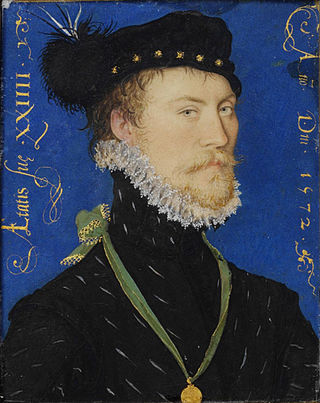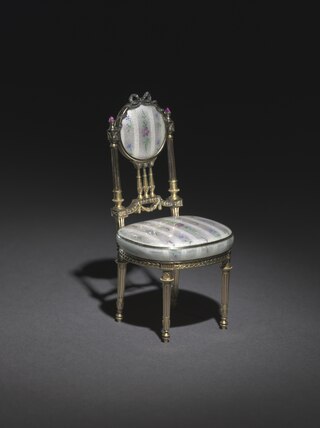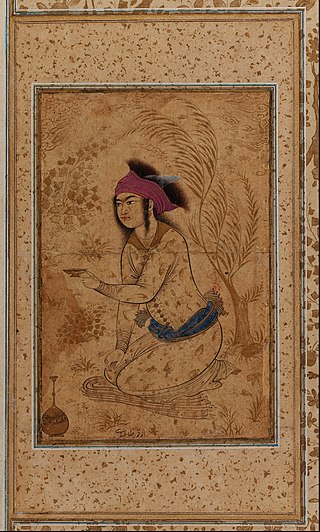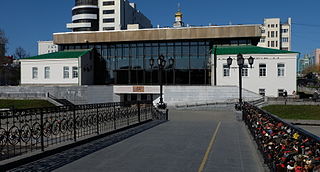
Irbit is a town in Sverdlovsk Oblast, Russia, located 203 kilometers (126 mi) from Yekaterinburg by train or 250 kilometers (160 mi) by car, on the right bank of the Nitsa. Population: 38,357 (2010 Census); 43,318 (2002 Census); 51,708 (1989 Census).

The Art Gallery of Ontario is an art museum in Toronto, Ontario, Canada, located in the Grange Park neighbourhood of downtown Toronto, on Dundas Street West. The building complex takes up 45,000 square metres (480,000 sq ft) of physical space, making it one of the largest art museums in North America and the second-largest art museum in Toronto, after the Royal Ontario Museum. In addition to exhibition spaces, the museum also houses an artist-in-residence office and studio, dining facilities, event spaces, gift shop, library and archives, theatre and lecture hall, research centre, and a workshop.

A portrait miniature is a miniature portrait painting, usually executed in gouache, watercolor, or enamel. Portrait miniatures developed out of the techniques of the miniatures in illuminated manuscripts, and were popular among 16th-century elites, mainly in England and France, and spread across the rest of Europe from the middle of the 18th century, remaining highly popular until the development of daguerreotypes and photography in the mid-19th century. They were usually intimate gifts given within the family, or by hopeful males in courtship, but some rulers, such as James I of England, gave large numbers as diplomatic or political gifts. They were especially likely to be painted when a family member was going to be absent for significant periods, whether a husband or son going to war or emigrating, or a daughter getting married.

A miniature is a small illustration used to decorate an ancient or medieval illuminated manuscript; the simple illustrations of the early codices having been miniated or delineated with that pigment. The generally small scale of such medieval pictures has led to etymological confusion with minuteness and to its application to small paintings, especially portrait miniatures, which did however grow from the same tradition and at least initially used similar techniques.

Miniature art includes paintings, engravings and sculptures that are very small; it has a long history that dates back to prehistory. The portrait miniature is the most common form in recent centuries, and from ancient times, engraved gems, often used as impression seals, and cylinder seals in various materials were very important. For example most surviving examples of figurative art from the Indus Valley civilization and in Minoan art are very small seals. Gothic boxwood miniatures are very small carvings in wood, used for rosary beads and the like.
Leonard Viktorovich Turzhansky was an impressionist painter in the Russian Empire and later the Soviet Union.

A Muraqqa is an album in book form containing Islamic miniature paintings and specimens of Islamic calligraphy, normally from several different sources, and perhaps other matter. The album was popular among collectors in the Islamic world, and by the later 16th century became the predominant format for miniature painting in the Persian Safavid, Mughal and Ottoman empires, greatly affecting the direction taken by the painting traditions of the Persian miniature, Ottoman miniature and Mughal miniature. The album largely replaced the full-scale illustrated manuscript of classics of Persian poetry, which had been the typical vehicle for the finest miniature painters up to that time. The great cost and delay of commissioning a top-quality example of such a work essentially restricted them to the ruler and a handful of other great figures, who usually had to maintain a whole workshop of calligraphers, artists and other craftsmen, with a librarian to manage the whole process.

Government Museum and Art Gallery, Chandigarh, is a premier museum of North India having collections of Gandharan sculptures, sculptures from ancient and medieval India, Pahari and Rajasthani miniature paintings. It owes its existence to the partition of India in August, 1947. Prior to the partition, much of the collections of art objects, paintings and sculptures present here were housed in the Central Museum, Lahore, the then capital of Punjab. The museum has one of the largest collection of Gandharan artefacts in the world.

Arseny Nikiforovich Semionov was a Soviet painter and art teacher, lived and worked in Leningrad, a member of the Leningrad Union of Artists, regarded as one of the representatives of the Leningrad school of painting, most famous for his landscape and cityscape paintings.

Dmitry Ivanovich Maevsky was a Soviet Russian painter, lived and worked in Leningrad, a member of the Leningrad Union of Artists, regarded as one of the representatives of the Leningrad school of painting, most famous for his lyrical landscapes.
Alyona Azernaya, born March 9, 1966, Ekaterinburg, Russia is a contemporary Russian naïve painter. Her name has been transliterated from Russian as : Alyona Azernaya, Alena Azernay, Aliona Azernaia, Elena Azernaya, Aliona Aziornaya.
Tatiana Vasilyevna Badanina is a Russian visual artist.

Misha Brusilovsky was a Russian artist, painter and graphic artist. He was a Member of the Russian union of artists, an honored artist of the Russian Federation, a distinguished member of Russian Academy of Arts, a laureate of the "G. S. Mosin prize" and a winner of the Sverdlovsk region Governor's prize "For outstanding achievements in literature and art".

"Our Contemporary" The Second Exhibition of Leningrad artists of 1972 became one of the notable event in Art of the USSR of 1972. The Exhibition took place in the State Russian Museum. Exhibition continued a series of art exhibitions of the 1970s, dedicated to image of our contemporary and opened one year before.
Ustad Bashir Ahmed is a Pakistani painter, also known as Mughal Miniature Painter.
Boris Vasilevich Kondrashin was a Russian and Soviet painter of socialist realism, member of the Union of artists since 1960, member of Union, republican and regional exhibitions.

The Yekaterinburg Museum of Fine Arts, established in 1986, is the largest art museum of the Urals region of Russia. It is based in Voevodina Street on the banks of the Iset River in the city of Yekaterinburg.
Tatiana Godovalnikova is a Russian contemporary artist. Museums in Russia, Germany and Japan as well as private collectors in Israel, Poland, Great Britain, Germany and Switzerland have Godovalnikova’ s art. Her works are presented also at Sevastopol Art Museum and the State Museum of Heroic Defence and Liberation of Sevastopol. In 1992 she became a member of the Union of Artists of Russia and the International Association of Art – UNESCO.

The State Museum Bhopal is located on Shymala Hills, in Bhopal, the capital city of the state of Madhya Pradesh in India. It is popular for its design and the breadth of its inventory of art and cultural artefacts. The museum holds a prominent role among the monuments and museums of Bhopal. It is open to the public from Tuesday to Sunday.
















